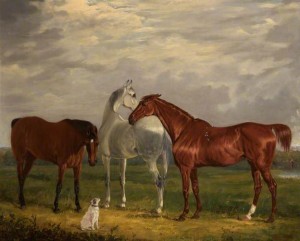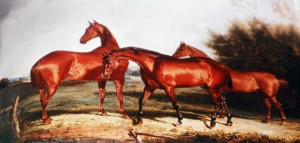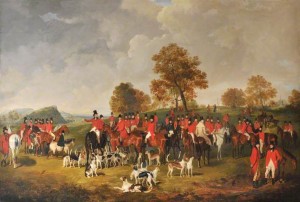Henry Calvert 1798-c.1869 for Thursday is Art Day
It’s lovely to be back writing a Thursday Art Day blog. The complexities of life has slowed me down with my blog’s of late but I’ll endeavour to get back into some sort of routine. I love talking about Art and especially Equestrian Art. I’ve several artists I have wanted to mention for some time so today I will start with Henry Calvert.

Three Horses of the 2nd Lord de Tabley and His Dog, ‘Vic’
I adore his horses, the luminosity and reflective light he captures in the horses coats is wonderful. So much health and vigour, not to mention the expressions on the horses faces in “Three Horses of the 2nd Lord de Tabley and His Dog, ‘Vic‘”.
The bay is interested in Vic, the chestnut clearly annoyed at Vic’s presence and the grey, well, he is totally engrossed in what’s going on elsewhere or maybe he could care less about Vic or his companions. It’s a fabulous composition and my favourite of the three.
Three Hunters in a Landscape
I included “The Cheshire Hunt” because it is a well known composition by Calvert but I also love “Three Hunters in a Landscape” again the wonderful gleaming reflection off the horses coats make them very alive. I agree with Sally Mitchell author of ‘The Dictionary of Equestrian British Artists’ that Henry Calvert certainly does deserve far more recognition.
The Cheshire Hunt
Henry Calvert 1798-c.1869
Born in Darlton near Tuxford, Nottinghamshire, Calvert, was the son of Charles Calvert senior, an amateur artist and agent for the Duke of Norfolk. Henry had eight brothers and sisters of which three, Charles, Michael Pease, and John, were also artists. As a child Henry moved to Manchester where he spent most of his working life until the 1860’s when he moved to Southport, where he eventually died.
He is comparatively little known and underestimated as an artist whose ability deserves greater recognition. His work is of a high standard, his horses well drawn, his composition good and his detail of items such as saddlery is accurate; as well as painting horses and sporting scenes he painted a variety of other animals including cattle portraits, and a few landscapes.
His best known works are three of hunt meets, each of which are engraved: ‘The Cheshire Hunt” 1839, “The Vine Hunt Meeting”, 1843 and “The Wynnstay Hunt”, 1855.
Most of his work was in oil but he did occasionally work in watercolour.
Although he would seem to have led a fairly active artistic life his work is now fairly rare. He exhibited sixty works at the Manchester Institute.


Leave a Reply